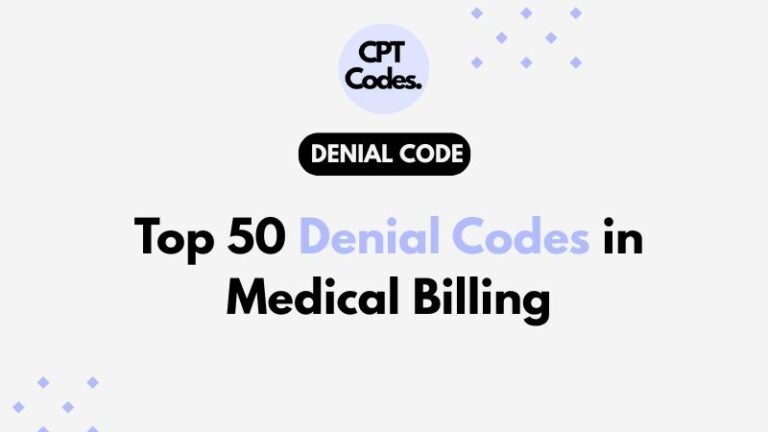In the world of medical billing, denial codes play a critical role in understanding why insurance companies reject or delay claims. Each denial code represents a specific reason for non-payment, allowing billing teams to identify, correct, and resubmit claims quickly.
Understanding these codes helps reduce claim denials, improve cash flow, and enhance revenue cycle performance. In this article, we’ll list the top 50 most common denial codes in medical billing and explain what they mean.
What Are Denial Codes?
Denial codes (also known as Claim Adjustment Reason Codes — CARCs) are standard codes used by insurance companies to explain why a medical claim was denied, reduced, or paid differently than billed.
These codes appear on the Explanation of Benefits (EOB) or Electronic Remittance Advice (ERA) documents. They help billers determine what action is needed — such as correcting patient information, submitting additional documentation, or verifying eligibility.
Top 50 Common Medical Billing Denial Codes
Here’s a comprehensive list of the top 50 denial codes and their meanings:
| Denial Code | Description |
|---|---|
| CO-4 | The procedure code is inconsistent with the modifier used. |
| CO-11 | Diagnosis code inconsistent with the procedure. |
| CO-16 | Claim/service lacks information or has submission/billing error. |
| CO-18 | Duplicate claim or service. |
| CO-22 | This care may be covered by another payer per coordination of benefits. |
| CO-24 | Charges covered under a capitation agreement/managed care plan. |
| CO-27 | Expenses incurred after patient’s coverage terminated. |
| CO-29 | The time limit for filing has expired. |
| CO-31 | Patient cannot be identified as our insured. |
| CO-32 | Our records indicate this service was already paid. |
| CO-45 | Charge exceeds fee schedule/maximum allowable. |
| CO-49 | These are non-covered services because they are not deemed medically necessary. |
| CO-50 | These are non-covered services. |
| CO-96 | Non-covered charge(s). |
| CO-97 | Payment adjusted for payment included in the allowance for another service. |
| CO-109 | Claim not covered by this payer. You must send to the correct payer. |
| CO-119 | Benefit maximum reached for this time period or occurrence. |
| CO-125 | Submission/billing error. |
| CO-128 | New patient qualifications not met. |
| CO-129 | Prior authorization/pre-certification required. |
| CO-151 | Payment adjusted because the payer deems the information submitted does not support this level of service. |
| CO-170 | Payment is denied when performed/billed by this type of provider. |
| CO-197 | Precertification/authorization not on file. |
| CO-198 | Precertification/authorization exceeded. |
| CO-204 | This service/equipment/drug is not covered under the patient’s plan. |
| CO-223 | Adjustment code for bundled or inclusive service. |
| CO-231 | The patient’s benefit maximum has been reached. |
| CO-236 | This procedure or treatment is experimental/investigational. |
| CO-246 | This procedure is not paid separately. |
| CO-247 | Deductible or coinsurance applies. |
| CO-252 | An attachment or documentation is missing or incomplete. |
| CO-253 | Missing operative report or medical documentation. |
| CO-256 | Patient is enrolled in a hospice plan. |
| CO-258 | Service not authorized for this location. |
| CO-259 | Missing patient’s date of birth. |
| CO-261 | Invalid referring provider information. |
| CO-262 | Invalid rendering provider NPI. |
| CO-263 | Invalid billing provider NPI. |
| CO-264 | Invalid taxonomy code. |
| CO-265 | Inconsistent place of service. |
| CO-266 | NDC (National Drug Code) missing or invalid. |
| CO-267 | Invalid TIN or EIN number. |
| CO-268 | Patient eligibility not verified. |
| CO-270 | Patient has other insurance coverage. |
| CO-271 | Coverage terminated prior to date of service. |
| CO-272 | Coverage not effective on the date of service. |
| CO-273 | Policy cancelled by the payer. |
| CO-274 | Service excluded from coverage. |
| CO-275 | Missing preauthorization number. |
| CO-276 | Claim/service denied because information was not received timely. |
| CO-277 | Claim/service denied for provider enrollment issue. |
Tips to Prevent Claim Denials
- Verify eligibility and benefits before providing services.
- Check preauthorization requirements for high-cost procedures.
- Ensure accurate coding and use appropriate modifiers.
- Submit claims on time within payer filing limits.
- Track denials regularly and correct recurring errors.
Final Thoughts
Denial management is one of the most crucial aspects of successful medical billing. By understanding these top 50 denial codes, billers can quickly identify issues, correct claims efficiently, and improve reimbursement rates.

